Diurnal Variation and Distribution of Short-Duration Heavy Rainfall in Beijing–Tianjin–Hebei Region in Summer Based on High-Density Automatic Weather Station Data
Abstract
1. Introduction
2. Data and Method
2.1. Data Quality Control
2.2. Data Processing Method
3. Analysis and Results
3.1. Spatial Distribution of SDHR
3.2. Diurnal Variation of SDHR
3.2.1. Diurnal Variation of the Spatial Distribution of SDHR
3.2.2. Diurnal Variation of Frequency and Propagation of SDHR in Summer
3.2.3. SDHR Frequencies for Each Month in Summer
Diurnal Variation of Cumulative SDHR Times of Multiple Stations for Each Month
Monthly Spatial Variation of SDHR Frequency
Diurnal Variation of SDHR Frequency in Each Month
4. Summary and Discussion
- (1)
- The spatial distribution of SDHR frequency in the BTH region has marked spatial discrepancy. The formation of SDHR in the BTH region in summer is affected substantially by the topography, interlaced land–sea underlying surface, and large cities. Areas prone to SDHR are located mainly in the southern foothills of the Yanshan Mountains in northeastern Hebei, the foothills of Beijing (southern foothills of the northern mountains, entrance of the trumpet-shaped topographic area, and southeastern foothills of the western mountain) and the area downwind of the Beijing urban area, areas inland of the west coast of Bohai Bay, and eastern slopes and southern foothills of the Taihang Mountains in western Hebei. In central and eastern parts of Hebei, Tianjin, and the southern foothills of the Yanshan Mountains in northeastern Hebei, the contribution rate of SDHR precipitation is considerable and can exceed 50%.
- (2)
- The diurnal variation of SDHR frequency in the BTH region in summer generally has dual-peaked characteristics with peak frequencies occurring in the evening (1500–1800) and first half of the night (0000–0100), and the lowest frequency occurring in the morning (0900–1300).
- (3)
- Affected by topography and the geographical location, SDHR frequency is low in the northwest and northeast mountainous areas of the BTH region; its diurnal variation has a single peak that occurs during 1500–2100 (afternoon/evening). The diurnal variation of SDHR frequency in the piedmont and plain areas is bimodal, with peaks appearing at 2200–0500 (evening/first half of the night) and 0900–1600 (second half of the night/early morning). In July, the SDHR frequency on the steep eastern slopes of the Taihang Mountains is high (much higher than on the gentle slopes) with a single peak of the diurnal variation occurring from afternoon to second half of the night (1300–0100). The SDHR that occurs at night has the characteristics of spreading eastward. In August, the SDHR frequency in the western and northern foothills of Beijing was high, with peaks in the bimodal diurnal variation appearing from afternoon to evening (1400–1900) and from midnight to early morning (2200–0400). The SDHR that occurs at night has obvious characteristics of eastward propagation.
- (4)
- In July and August, SDHR occurs frequently in the areas inland of the west coast of Bohai Bay. The diurnal variation of the SDHR frequency was approximately bimodal; the main peak occurs at 1400–0000 (afternoon/first half of the night), while the second peak appears at 0500–0600 (early morning). The SDHR that occurs in the afternoon shows a tendency for northward propagation.
Author Contributions
Funding
Institutional Review Board Statement
Informed Consent Statement
Data Availability Statement
Acknowledgments
Conflicts of Interest
References
- Davis, R.S. Flash flood forecast and detection methods, severe convective storms. In Meteorological Monographs; American Meteorological Society: Boston, MA, USA, 2001; Volume 28, pp. 481–525. [Google Scholar] [CrossRef]
- Brooks, H.E.; Stensrud, D.J. Climatology of heavy rain events in the United States from hourly precipitation observation. Mon. Weather. Rev. 2000, 128, 1194–1201. [Google Scholar] [CrossRef]
- Zhang, H.; Zhai, P. Temporal and spatial characteristics of extreme hourly precipitation over Eastern China in the warm season. Adv. Atmos. Sci. 2011, 28, 1177–1183. [Google Scholar] [CrossRef]
- Li, H.; Cui, X.; Zhang, D.L. A statistical analysis of hourly heavy rainfall events over the Beijing metropolitan region during the warm seasons of 2007–2014. Int. J. Climatol. 2017, 37, 4027–4042. [Google Scholar] [CrossRef]
- Zhang, J.C.; Lin, Z.G. Climate of China, 1985. Shanghai; Shanghai Science and Technology Press: Shanghai, China, 1985; pp. 411–436. [Google Scholar]
- Shen, L.L.; He, J.H.; Zhou, X.J.; Chen, L.X.; Zhu, C.W. The regional variabilities of the summer rainfall in China and its relation with anomalous moisture transport during the recent 50 years. Acta Meteorol. Sin. 2010, 68, 918–931. (In Chinese) [Google Scholar]
- Huang, Y.; Feng, G.L.; Dong, W.J. Temporal changed in the patterns extreme air temperature and precipitation in the various regions of China in recent 50 years. Acta Meteorol. Sin. 2011, 69, 125–136. (In Chinese) [Google Scholar]
- Yu, R.C.; Zhou, T.J.; Xiong, A.Y.; Zhu, Y.J.; Li, J.M. Diurnal variation of summer precipitation over contiguous China. Geophys. Res. Lett. 2007, 34, L01704. [Google Scholar] [CrossRef]
- Yu, R.C.; Xu, Y.P.; Zhou, T.J.; Li, J. Relation between rainfall duration and diurnal variation in the warm season precipitation over central eastern China. Geophys. Res. Lett. 2007, 34, L13703. [Google Scholar] [CrossRef]
- Yao, L.; Li, X.Q.; Zhang, L.M. Spatial-Temporal Distribution Characteristics of Hourly Rain Intensity in China. Meteorol. Mon. 2009, 35, 80–87. (In Chinese) [Google Scholar]
- Chen, J.; Zheng, Y.G.; Zhang, X.L.; Zhu, P.J. Analysis of climatological distribution and diurnal variations of the short-duration heavy rain and its relation with diurnal variations of the MCSs over china during the warm season. Acta Meteorol. Sin. 2013, 71, 367–382. (In Chinese) [Google Scholar]
- Chen, C.S.; Chen, Y.L.; Liu, C.L.; Lin, P.L.; Chen, W.C. Statistics of Heavy Rainfall Occurrences in Taiwan. Weather. Forecast. 2007, 22, 981–1002. [Google Scholar] [CrossRef]
- Shen, L.L.; Zhang, Y.X.; Long, L.X.; Sun, Y.; Kang, Z.M. Characteristics of extreme precipitation in Beijing-Tianjin-Hebei region from 1981 to 2016. Torrential Rain Disasters 2018, 37, 428–434. (In Chinese) [Google Scholar]
- Chen, M.X.; Wang, Y.C.; Gao, F.; Xiao, X. Diurnal variations in convective storm activity over contiguous North China during the warm season based on radar mosaic climatology. J. Geophys. Res. Atmos. 2012, 117, D20115. [Google Scholar] [CrossRef]
- Yin, S.Q.; Li, W.J.; Chen, D.L.; Jeong, J.H.; Guo, W.L. Diurnal Variations of Summer Precipitation in the Beijing Area and the Possible Effect of Topography and Urbanization. Adv. Atmos. Sci. 2011, 28, 725–734. [Google Scholar] [CrossRef]
- Yuan, Y.F.; Zhai, P.M.; Chen, Y.; Li, J. Hourly extreme precipitation changes under the influences of regional and urbanization effects in Beijing. Int. J. Climatol. 2021, 41, 1179–1189. [Google Scholar] [CrossRef]
- Li, J.; Yu, R.; Wang, J. Diurnal variation of summer precipitation in Beijing China. Sci. Bull. 2008, 7, 829–832. (In Chinese) [Google Scholar]
- Yang, P.; Ren, G.Y.; Hou, W.; Liu, W.D. Spatial and diurnal characteristics of summer rainfall over Beijing Municipality based on a high-density AWS dataset. Int. J. Climatol. 2013, 33, 2769–2780. [Google Scholar] [CrossRef]
- Zheng, Z.; Qi, W.; Li, Q.; Li, L. Statistical characteristics of precipitation in summer in Beijing area during 2007–2011. Clim. Environ. Res. 2015, 20, 201–208. (In Chinese) [Google Scholar]
- Yang, P.; Ren, G.Y.; Yan, P.C. Evidence for a Strong Association of Short-Duration Intense Rainfall with Urbanization in the Beijing Urban Area. Int. J. Climatol. 2013, 30, 5851–5870. [Google Scholar] [CrossRef]
- Wang, G.R.; Wang, L. Temporal and spatial distribution of short-time heavy rain of Beijing in summer. Torrential Rain Disasters 2013, 32, 276–279. (In Chinese) [Google Scholar]
- Haiden, T.; Kann, A.; Wittmann, C.; Pistotnik, G.; Bica, B.; Gruber, C. The Integrated Nowcasting through Comprehensive Analysis (INCA) system and its validation over the eastern Alpine region. Weather. Forecast. 2011, 26, 166–183. [Google Scholar] [CrossRef]
- Carbone, R.E.; Tuttle, J.D.; Ahijevich, D.A.; Trier, S.B. Inferences of predictability associated with warm season precipitation episodes. J. Atmos. Sci. 2002, 59, 2033–2056. [Google Scholar] [CrossRef]
- Carbone, R.E.; Tuttle, J.D. Rainfall occurrence in the U.S. Warm season: The diurnal cycle. Int. J. Climatol. 2008, 21, 4132–4146. [Google Scholar] [CrossRef]
- Lin, P.F.; Chang, P.L.; Jou, J.D.; Wilson, J.W.; Roberts, R.D. Warm season afternoon thunderstorm characteristics under weak synoptic-scale forcing over Taiwan island. Weather. Forecast. 2011, 26, 44–60. [Google Scholar] [CrossRef]
- Guo, J.; Xiong, M.M.; Huang, H. Analysis of diurnal variation characteristics of rainfall during warm season in Beijing-Tianjin-Hebei region. J. Mar. Meteorol. 2019, 39, 58–67. [Google Scholar] [CrossRef]
- Gu, T.M. Climate of North China, Beijing; Meteorological Press: Beijing, China, 1991; pp. 44–45. [Google Scholar]
- Jiao, M.Y.; Bi, B.G. Mesoscale Structure Analysis of Topography induced Heavy Rainfall in Beijing in summer. Meteorol. Mon. 2008, 31, 9–13. (in Chinese). [Google Scholar]
- Zhang, Y. The effect of topography on precipitation. Meteorol. Mon. 1983, 2, 9–13. (In Chinese) [Google Scholar]
- Chen, B.; Yu, H.G. The weather and climate characteristics of the sea land breeze in the west of Bohai Bay. Mar. Sci. Bull. 1989, 8, 23–29. [Google Scholar]
- Huff, F.A.; Vogel, J.L. Urban, topographic and diurnal effects on rainfall in the St. Louis region. J. Appl. Meteorol. 1978, 17, 565–577. [Google Scholar] [CrossRef]
- Sanderson, M.; Gorski, R. The effect of metropolitan Detroit-Windsor on precipitation. J. Appl. Meteorol. 1978, 17, 423–427. [Google Scholar] [CrossRef][Green Version]
- Changnon, S.A. Rainfall changes in summer caused by St. Louis. Science 1979, 205, 402–404. [Google Scholar] [CrossRef]
- Changnon, S.A.; Semonin, R.G.; Auer, A.H.; Braham, R.R.; Hales, J. METROMEX: A Review and Summary 1981; American Meteorological Society: Boston, MA, USA, 1981; pp. 40–81. [Google Scholar]
- Changnon, S.A.; Shealy, R.T.; Scott, R.W. Precipitation changes in fall, winter, and spring caused by St. Louis. J. Appl. Meteorol. 1991, 30, 126–134. [Google Scholar] [CrossRef][Green Version]
- Changnon, S.A. Inadvertent weather modification in urban areas: Lessons for global climate change. Bull. Am. Meteorol. Soc. 1992, 73, 619–627. [Google Scholar] [CrossRef]
- Braham, R.R.; Semonin, R.G.; Auer, A.H.; Changnon, S.A.; Hales, J.M. METROMEX: Summary of urban effects on clouds and rain. Bull. Am. Meteorol. Soc. 1981, 40, 141–152. [Google Scholar]
- Diem, J.E.; Brown, D.P. Anthropogenic impacts on summer precipitation in central Arizona. Prof. Geogr. 2003, 55, 343–355. [Google Scholar]
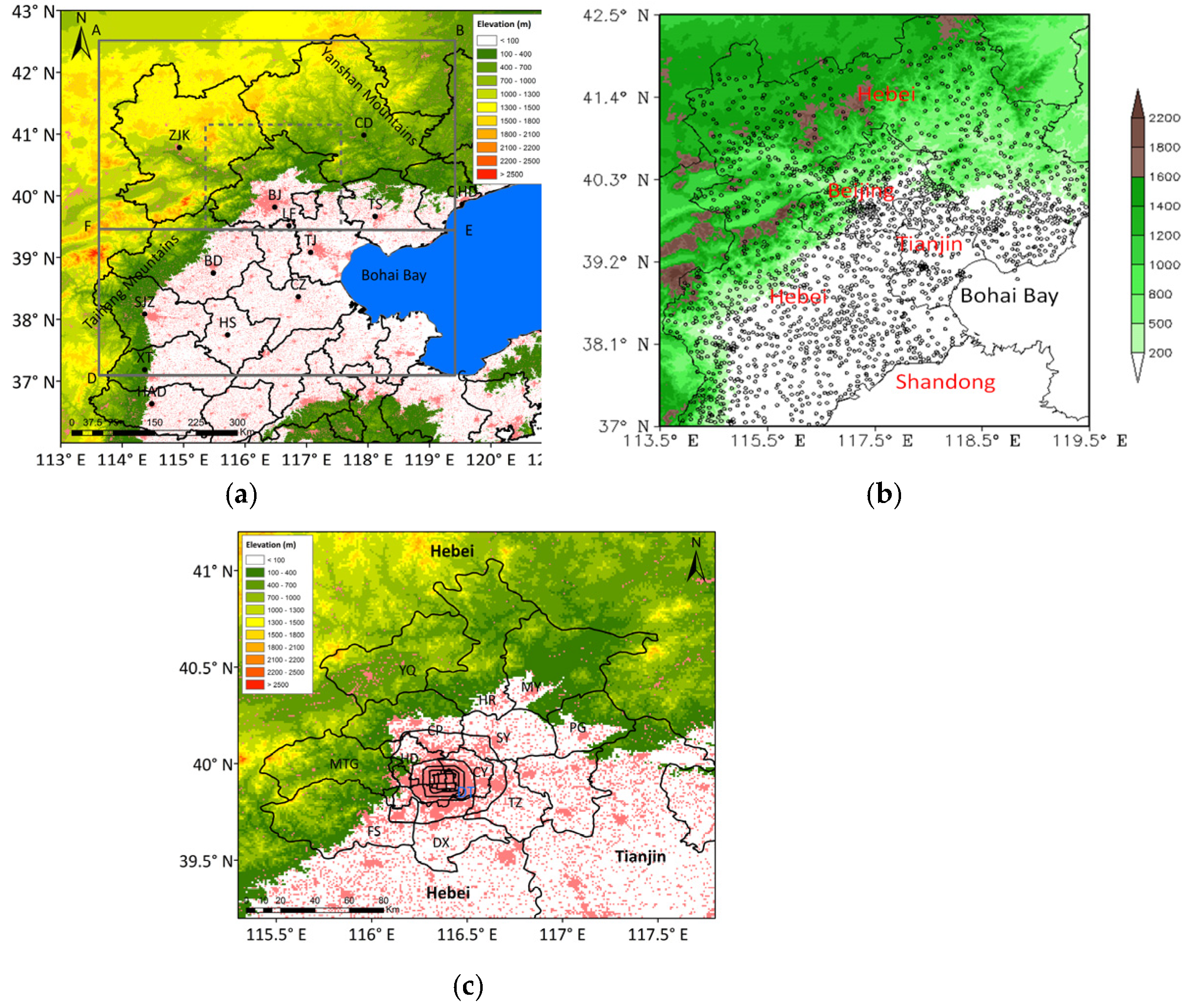

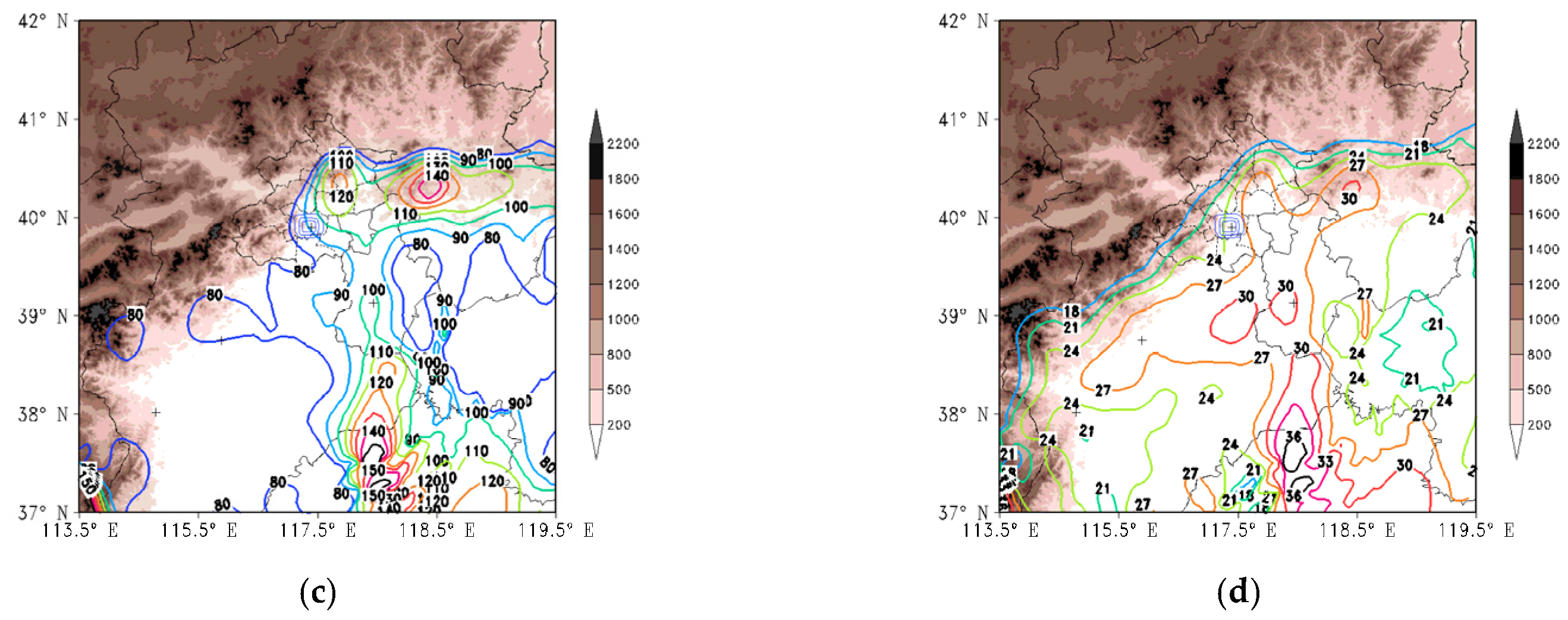
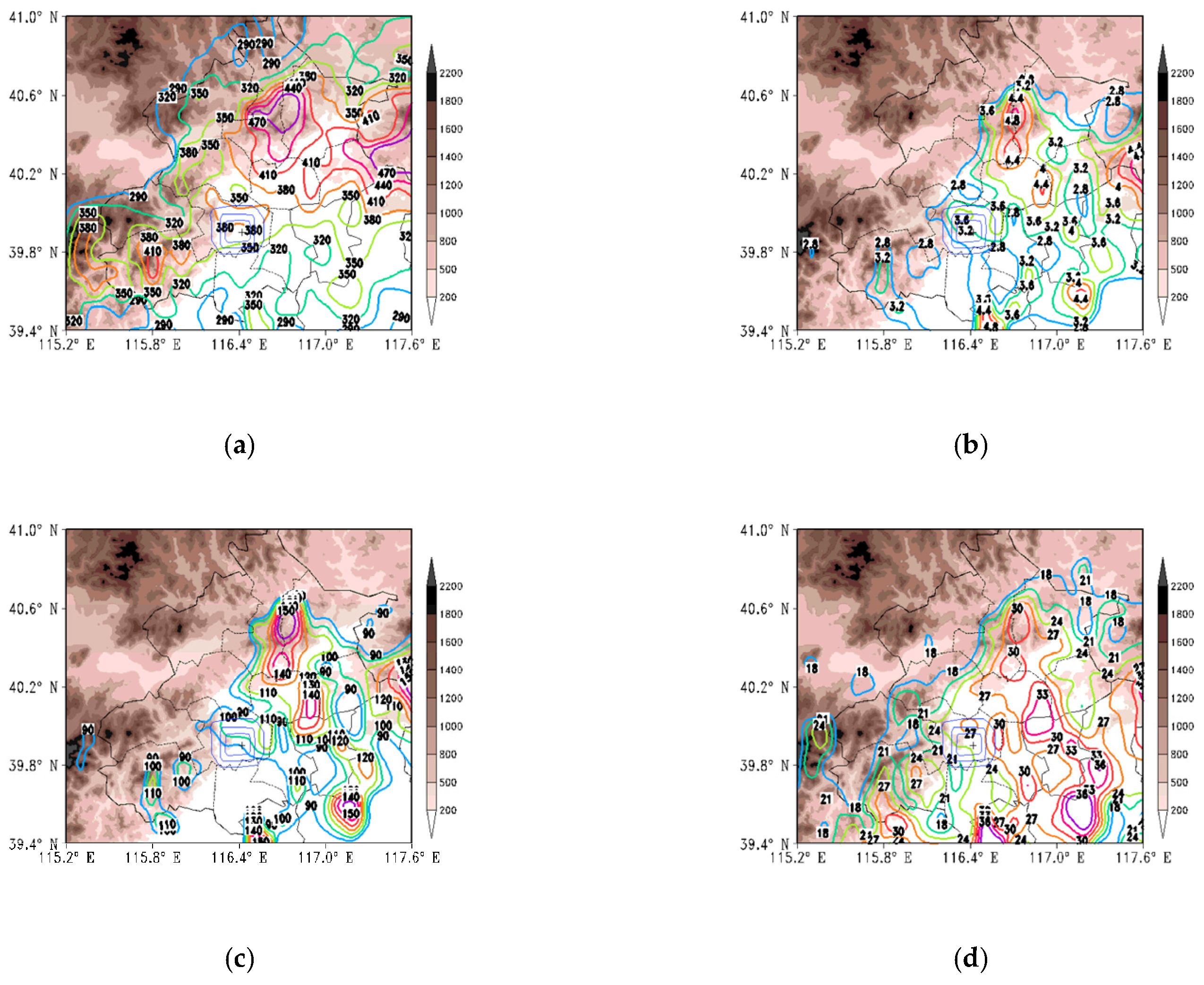
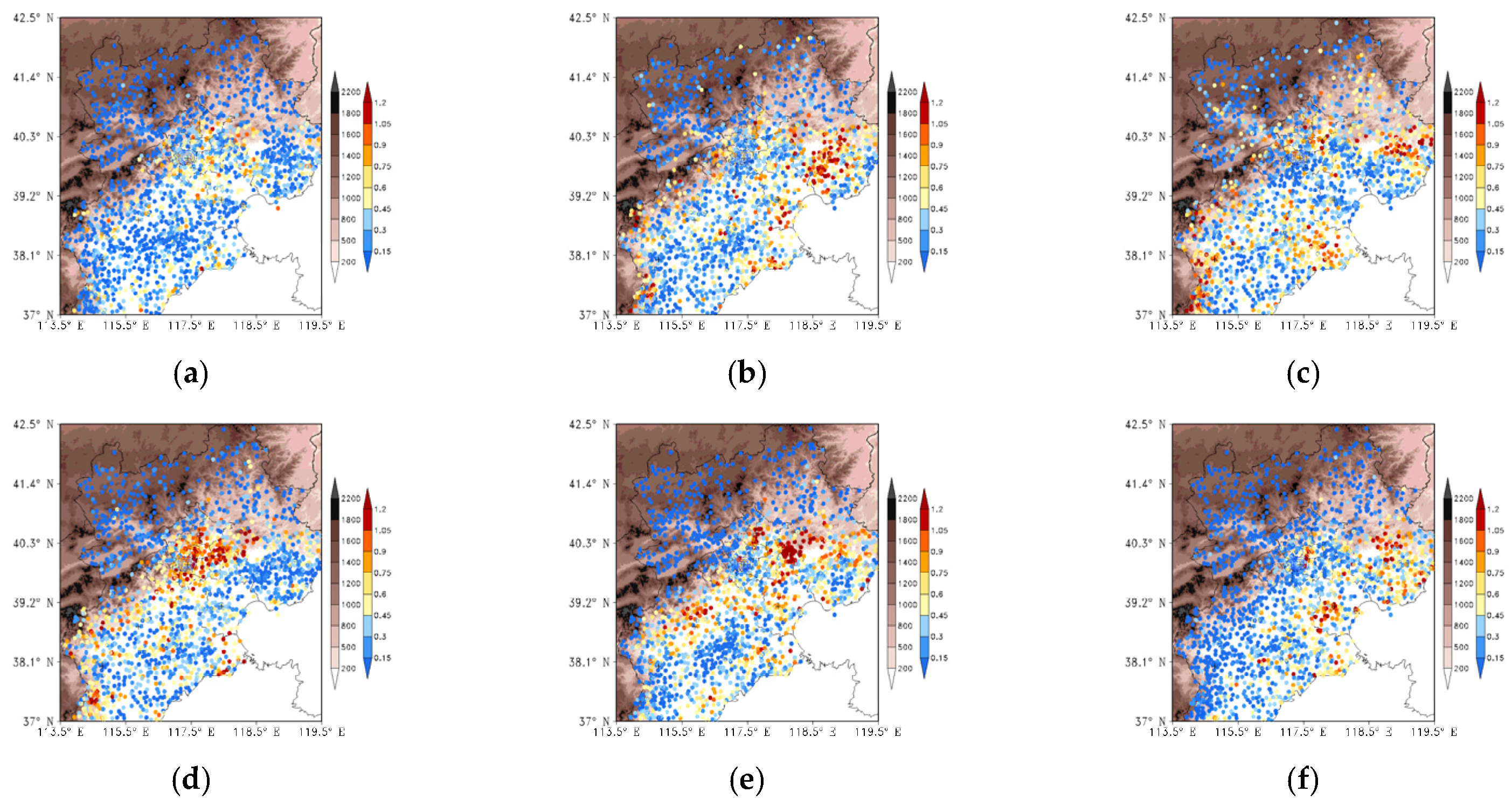
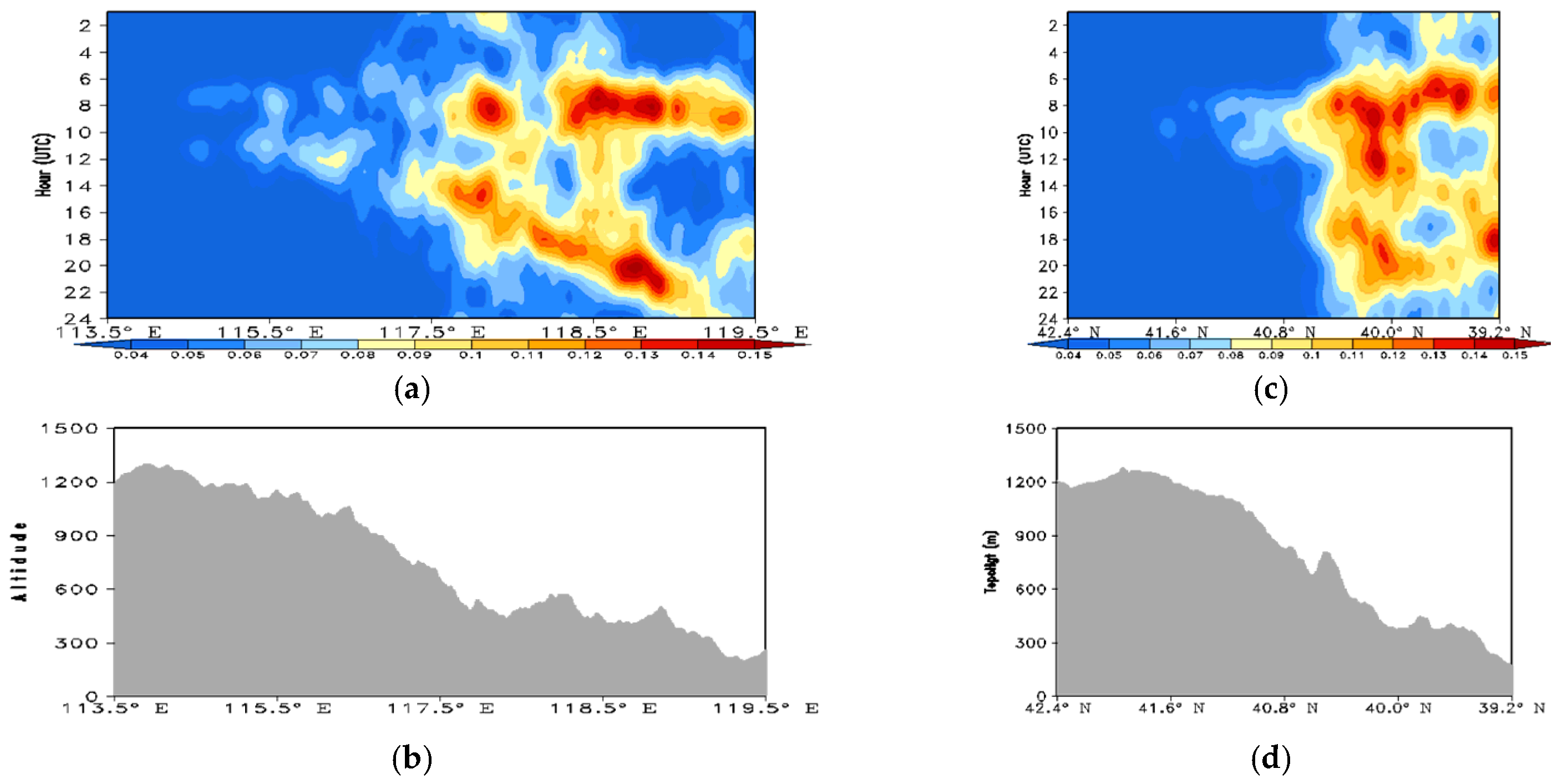
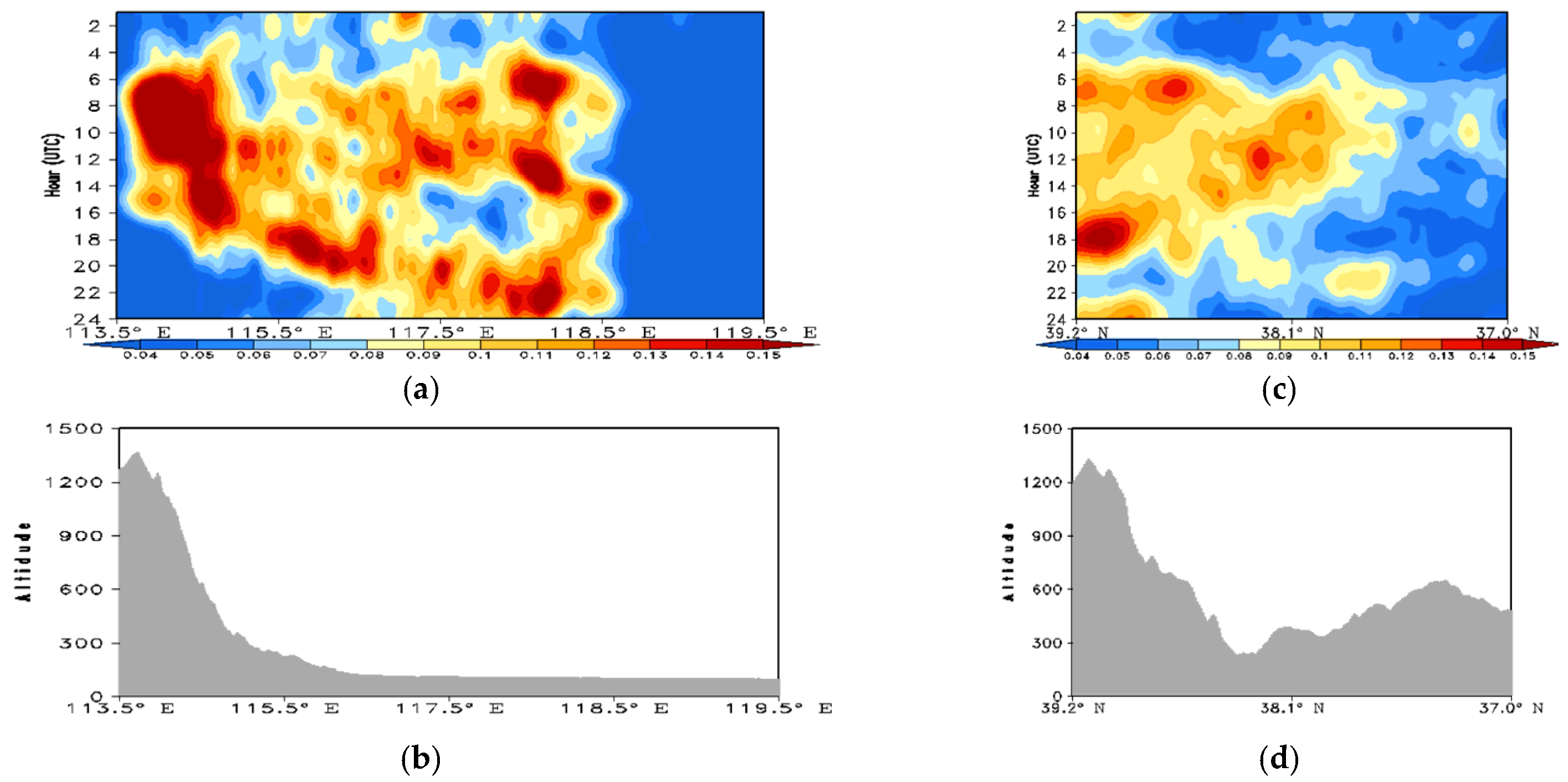


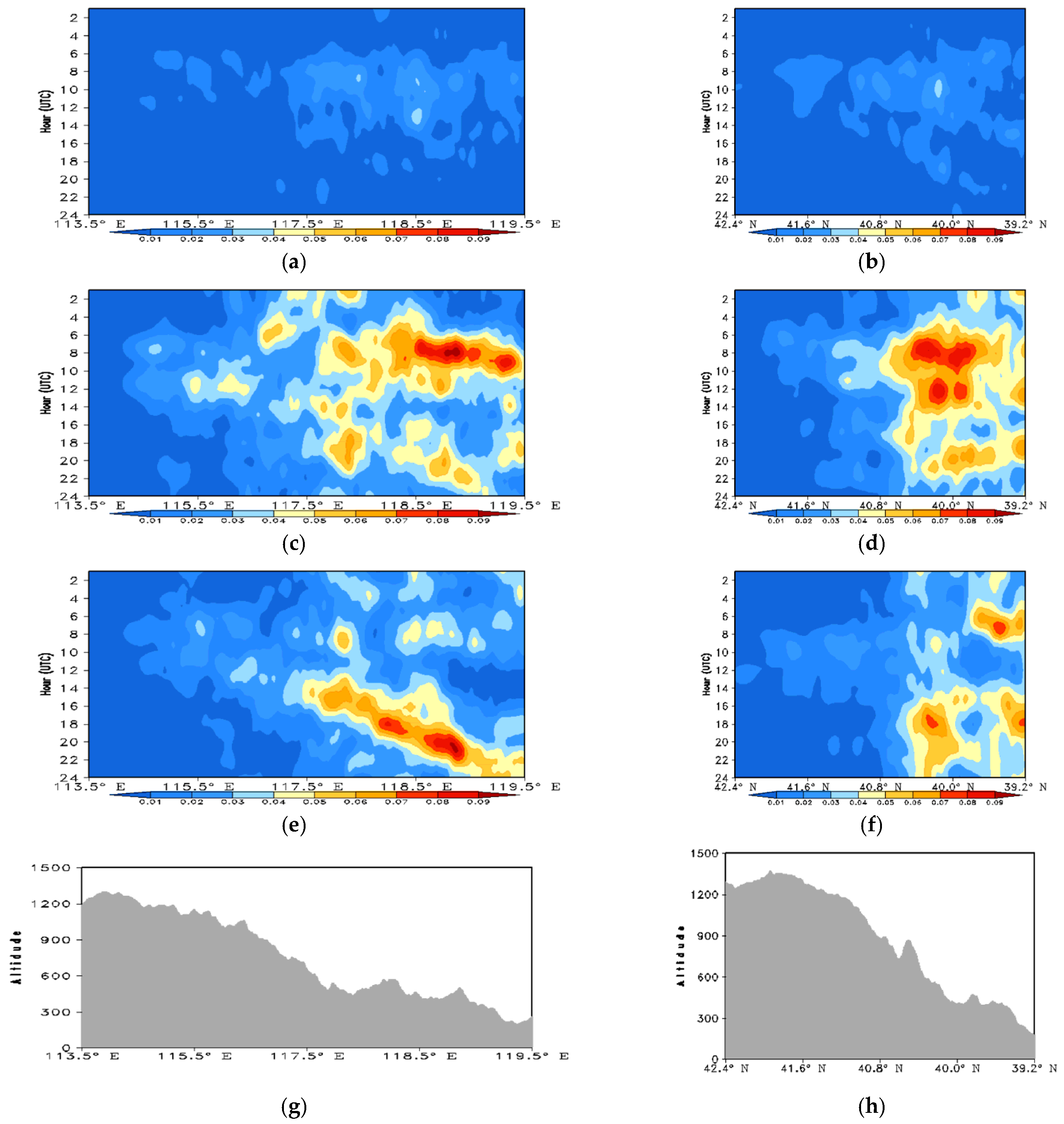
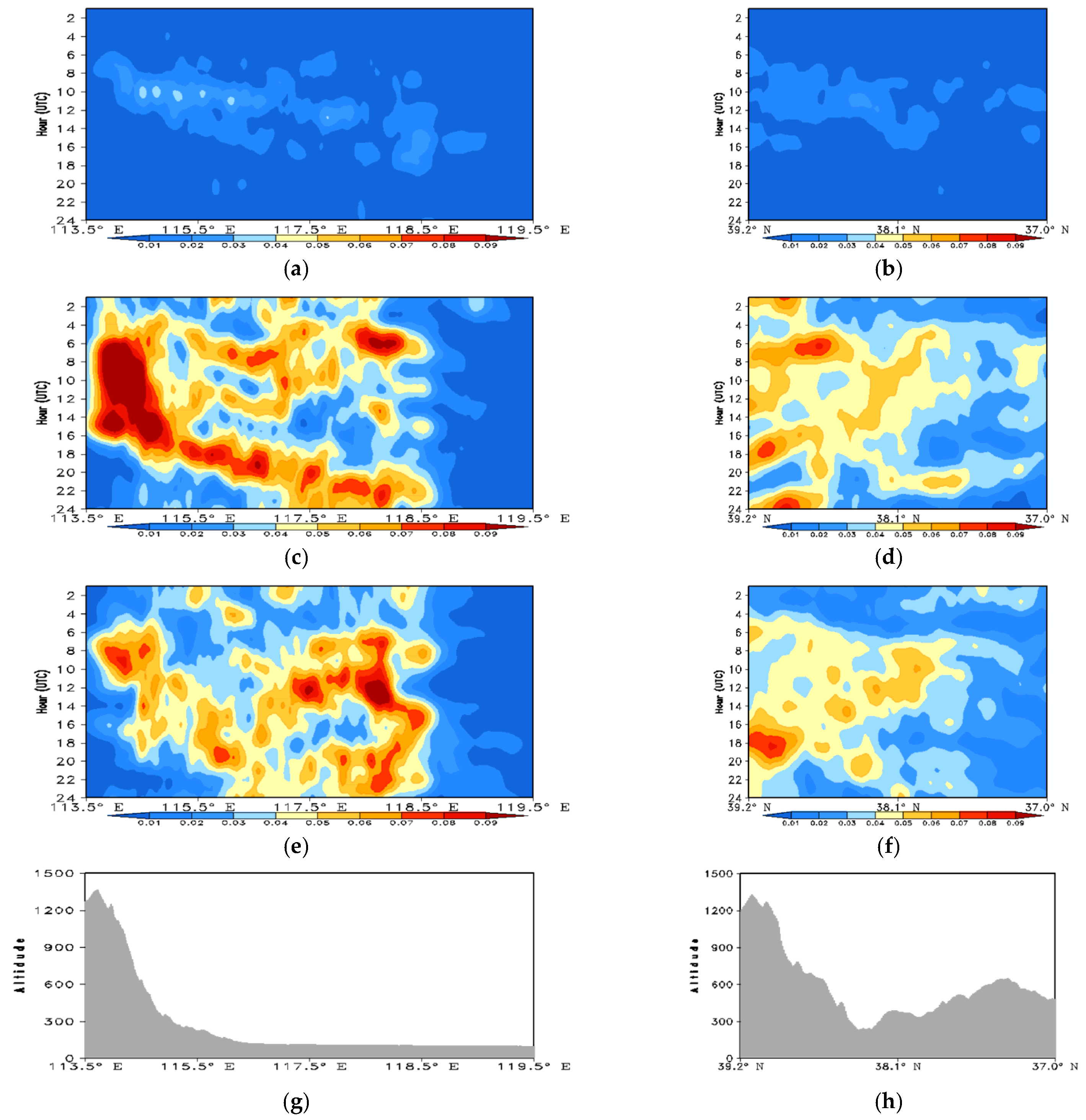
Publisher’s Note: MDPI stays neutral with regard to jurisdictional claims in published maps and institutional affiliations. |
© 2021 by the authors. Licensee MDPI, Basel, Switzerland. This article is an open access article distributed under the terms and conditions of the Creative Commons Attribution (CC BY) license (https://creativecommons.org/licenses/by/4.0/).
Share and Cite
Cheng, C.; Li, Q.; Dou, Y.; Wang, Y. Diurnal Variation and Distribution of Short-Duration Heavy Rainfall in Beijing–Tianjin–Hebei Region in Summer Based on High-Density Automatic Weather Station Data. Atmosphere 2021, 12, 1263. https://doi.org/10.3390/atmos12101263
Cheng C, Li Q, Dou Y, Wang Y. Diurnal Variation and Distribution of Short-Duration Heavy Rainfall in Beijing–Tianjin–Hebei Region in Summer Based on High-Density Automatic Weather Station Data. Atmosphere. 2021; 12(10):1263. https://doi.org/10.3390/atmos12101263
Chicago/Turabian StyleCheng, Conglan, Qingchun Li, Youjun Dou, and Yaoting Wang. 2021. "Diurnal Variation and Distribution of Short-Duration Heavy Rainfall in Beijing–Tianjin–Hebei Region in Summer Based on High-Density Automatic Weather Station Data" Atmosphere 12, no. 10: 1263. https://doi.org/10.3390/atmos12101263
APA StyleCheng, C., Li, Q., Dou, Y., & Wang, Y. (2021). Diurnal Variation and Distribution of Short-Duration Heavy Rainfall in Beijing–Tianjin–Hebei Region in Summer Based on High-Density Automatic Weather Station Data. Atmosphere, 12(10), 1263. https://doi.org/10.3390/atmos12101263




